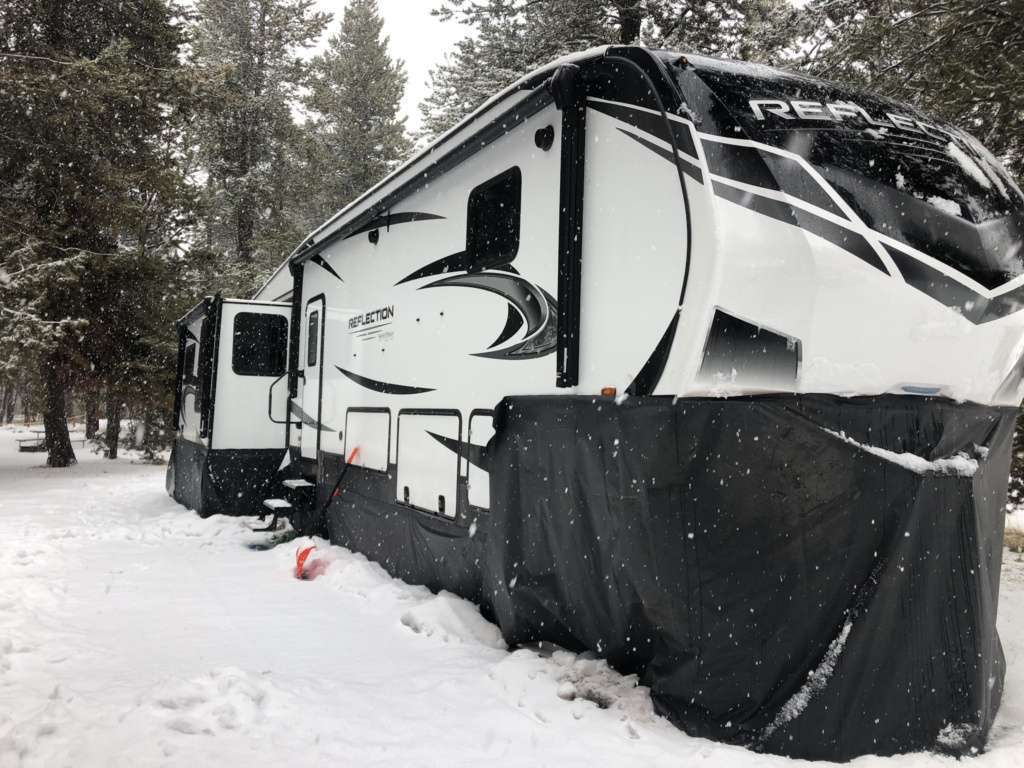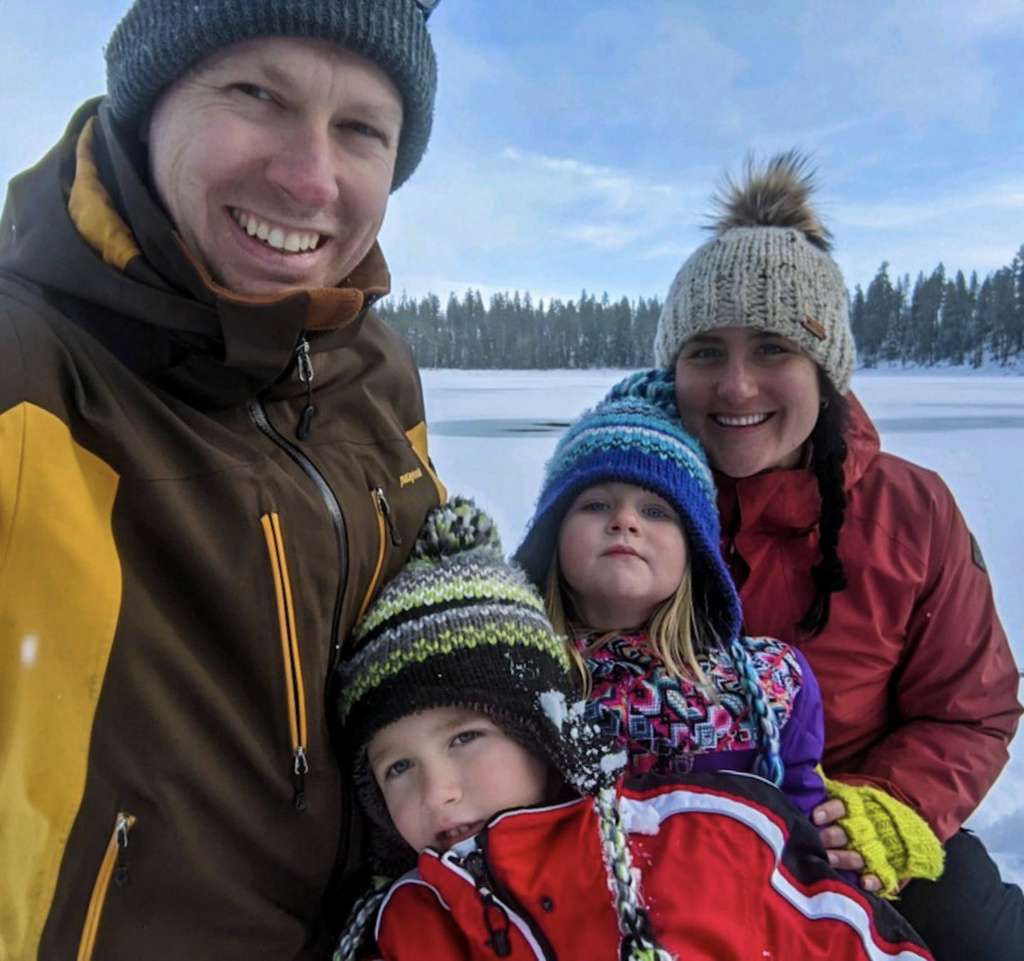How To Insulate Rv Slide Outs
Braving the winter elements in an RV requires planning and preparation. It'southward important to consider the weather condition you may meet and plan how to stay prophylactic and warm in a winter environment. Here are a few tips and tricks for enhancing your wintertime RV camping feel.
How to Keep an RV Warm in the Wintertime
When considering RV camping ground in the wintertime, one of the biggest questions is probably, how do yous keep the RV warm and toasty? Mostly RVs lack the insulation like houses have and aren't fabricated for cold temperatures. Luckily, at that place are a number of things you can practise to your rig to keep it warm.
Insulation is fundamental to keeping an RV warm in the winter. Insulate windows with plastic on both the outside and the within. Then apply thermal drapes, especially on any northward-facing windows, or utilize quilted or polar fleece textile; tack the textile to the walls with velcro if possible to preclude drafts. Any windows not used for light can be covered with rigid cream insulation likewise. Conditions strip effectually doors and cover the door with a heavy blanket or insulated curtain to reduce cold air leaks.
Cover vent openings with RV vent plugs made specially for this purpose, or utilize foam-lath insulation cut to fit with duct record wrapping to strengthen the board. Also, leave a "handle" so that the vent embrace is easily removable for ventilation when needed.
Insulate around all plumbing and electrical openings to the outside. Utilise a low-expansion spray-in cream so there is no potential for impairment to pipes or wires. Stuffing insulation in holes only keeps cold out if the leaks are sealed first.
Slide-outs can be covered on the sides with rigid foam taped to the sides. If you cover the slide-out roof, brand sure you angle the insulation so h2o flows away from the RV. Heat from the inside will cook snow that accumulates and then snow removal from the RV slide-outs (and the roof) is important to avert creating damage.

Slide-outs can be covered on the sides with rigid foam taped to the sides. If you cover the slide-out roof, brand sure yous angle the insulation so water flows away from the RV. Heat from the inside will melt snow that accumulates so snow removal from the RV slide-outs (and the roof) is important to avert creating damage.
People and pets create moisture in an RV when the weather outside is cold and the inside of the rig is warm. Condensation volition form on windows and walls with the potential for creating an unhealthy surroundings. Try to maintain humidity at 30-40%. A adept dehumidifier will help control the humidity level in your RV.
Supplement your furnace with a fan-forced ceramic heater which remains cool to the touch and usually offers temperature controls and even oscillation. If your RV has a fireplace, utilize it to not only requite ambiance, simply to offer an additional heat source. Consider throw rugs to insulate floors.
Flannel sheets, down comforters, and pets and people to caress are besides great to help keep y'all warm in wintertime RV living!

Flannel sheets, downwards comforters, and pets and people to cuddle are besides groovy to help keep you warm in winter RV living!
Special attention needs to be given to your solar system as well. Go Power! offers these tips for temperatures beneath 32℉;
- Cover your solar panels with a protective material that does not allow light to pass through. Nosotros recommend using a night-coloured tarp or plywood, with plywood being the all-time option.
- Characterization your solar panel wires 'positive' and 'negative'
- Unhook your solar panels from your solar controller
- Fix wire basics on the positive and negative leads from the solar panels
- Disconnect your batteries and store them inside in a warm, dry place preferably off the floor on something like a wooden pallet. (AGMs can handle temps lower than 20℉)
- Check the batteries monthly and charge them if necessary
How to Proceed RV Pipes from Freezing
While some RVs are "all seasons", well-nigh are not adequately insulated for long periods of exposure to freezing temperatures. Any external showerheads or faucets that are not used in winter should be drained and protected from the elements. Since RV pipes lie mostly underneath the motorhome, keeping pipes from freezing is essential. Ane of the all-time ways to practice this is with oestrus wrap or insulation around the pipes. Too, make sure there is a comprehend over the water source if you lot take hook-ups and invest in a heated water hose. Leaving a baste in faucets will also assistance prevent pipes from freezing, as will keeping cupboard doors under sinks open to allow the RV'southward oestrus to enter. You lot can also merely fill your fresh water tank and eliminate a hose hook-up birthday.
The grey and black tanks should be insulated if you are going to wintertime in your RV. Electric belongings tank heaters will reduce the risk of waste material thing freezing, as will keeping the tanks closed and just draining periodically. Using PVC piping rather than flexible hosing, which can easily break if it becomes breakable from extreme common cold, will provide additional protection.
How to Skirt an RV for Wintertime
Skirting your RV is imperative for winter camping or living. Keeping the underbelly and the bays with batteries, the pipes and fittings, the valves and hoses from freezing requires keeping the underside of the RV warm. Skirting will also assist in keeping the inside, particularly floors, warm every bit well. Choices for insulation include vinyl, custom or DIY made from tarp vinyl, clear plastic, or recycled billboard vinyl; inflatable air skirts; foam board, and plywood or particle board. At that place are innumerable videos and DIY blogs on how to skirt your RV for wintertime.
Commercial skirting is available and tin be professionally installed. The pros of a professional installation are appearance, convenience, ecology friendliness, and re-usability. The cons are price, locating someone to install information technology, and the inevitability of having to put it on yourself once you lot reach your destination.
Our choice was DIY skirting made from recycled billboard vinyl attached past heavy duty claw and loop fasteners. While it took some labor to skirt our fifth cycle, the recycled billboard vinyl worked well keeping out the common cold for the time we were in winter temperatures.
Wintertime RV camping ground can be challenging, only with a little planning and training, you can brave the elements and find a whole new world opens in a wintertime mural. Package up and enjoy!
Source: https://gopowersolar.com/winter-rv-camping-tips-tricks/

0 Response to "How To Insulate Rv Slide Outs"
Post a Comment